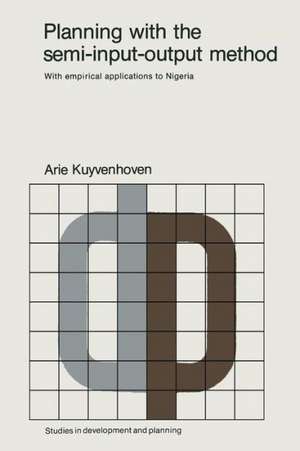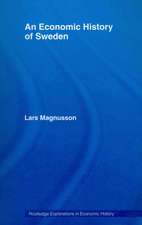Planning with the semi-input-output method: With empirical applications to Nigeria: Studies in Development and Planning, cartea 10
Autor A. Kuyenhovenen Limba Engleză Paperback – 8 mar 2012
Preț: 386.39 lei
Nou
Puncte Express: 580
Preț estimativ în valută:
73.93€ • 77.61$ • 61.37£
73.93€ • 77.61$ • 61.37£
Carte tipărită la comandă
Livrare economică 10-24 aprilie
Preluare comenzi: 021 569.72.76
Specificații
ISBN-13: 9781468469608
ISBN-10: 1468469606
Pagini: 280
Ilustrații: 278 p.
Dimensiuni: 152 x 229 x 15 mm
Greutate: 0.38 kg
Ediția:Softcover reprint of the original 1st ed. 1978
Editura: Springer Us
Colecția Springer
Seria Studies in Development and Planning
Locul publicării:New York, NY, United States
ISBN-10: 1468469606
Pagini: 280
Ilustrații: 278 p.
Dimensiuni: 152 x 229 x 15 mm
Greutate: 0.38 kg
Ediția:Softcover reprint of the original 1st ed. 1978
Editura: Springer Us
Colecția Springer
Seria Studies in Development and Planning
Locul publicării:New York, NY, United States
Public țintă
ResearchCuprins
1. Introduction.- 1.1. Scope and purpose of the study.- 1.2. Outline of the contents.- 1.3. A reader’s guide.- 2. Planning in Developing Countries.- 2.1. Simplifying the planning process: planning in stages.- 2.2. Saving, income distribution and project choice.- 2.3. Optimal policies, government control and accounting prices.- 2.4. Complementarity and substitution in planning models.- 2.5. Direct substitution.- 2.6. Indirect substitution.- 2.7. Incremental planning.- 3. Planning for an Open Economy: The Analytical Framework.- 3.1. Introduction.- 3.2. A simple model for a completely open economy.- 3.3. The introduction of national goods.- 3.4. International goods and investment demand for national goods.- 4. The Semi-Input-Output Method.- 4.1. Introduction.- 4.2. National and international sectors: concepts and measurement.- 4.3. Intermediate goods: the semi-input-output method.- 4.4. The role of accounting prices.- 4.5. Selection criteria, consumption and balance of payments effects.- 5. Semi-Input-Output and Multisectoral Planning.- 5.1. Introduction.- 5.2. Planning at the sectoral level.- 5.3. Multisector planning with the semi-input-output method.- 5.4. Linear programming formulations of the semi-input-output method.- 5.5. Special problems.- 6. Semi-Input-Output and Project Planning.- 6.1. Introduction.- 6.2. Essentials of project analysis and appraisal.- 6.3. Semi-input-output analysis at the project stage: estimation of effects.- 6.4. Valuation and accounting prices.- 6.5. Selection of projects.- 6.6. Towards consistency in project and sector appraisal.- 6.7. Semi-input-output and Little-Mirrlees.- 7. A Case Study for Nigeria.- 7.1. Introduction.- 7.2. Structure and development of the Nigerian economy.- 7.3. Application of the semi-input-output method.- 7.4.Investment appraisal at market prices.- 7.5. Investment appraisal at accounting prices.- 7.6. Conclusions.- 8. Summary and Conclusions.- 8.1. The method: analysis and presentation.- 8.2. Application of the method.- Appendix A Derivation of a capital stock-flow conversion factor.- Appendix B Estimation of structural coefficients for Nigeria.- Appendix C List of sectors and projects and their characteristics.- References.- Author Index.


















